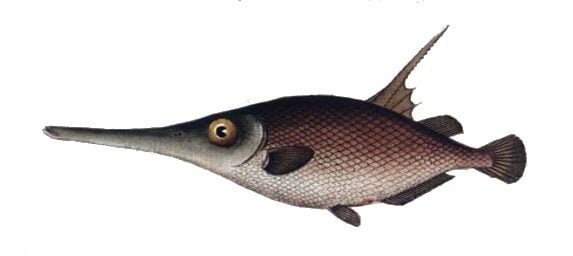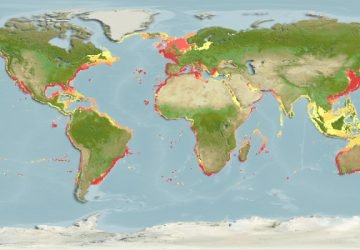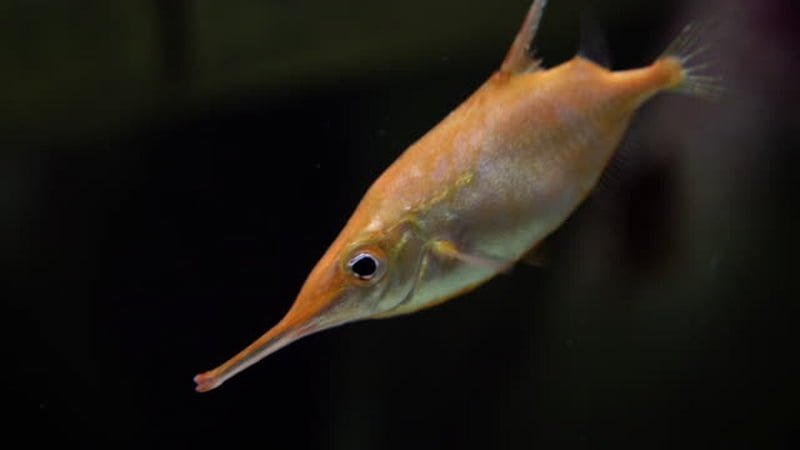Macroramphosus Scolopax
– Longspine Snipefish –

| Conservation status |
|---|
 Least Concern (IUCN 3.1)[1] |
| Scientific classification |
Macroramphosus scolopax
(Linnaeus, 1758)
| Kingdom: | Animalia |
| Phylum: | Chordata |
| Class: | Actinopterygii |
| Order: | Syngnathiformes |
| Family: | Macroramphosidae |
| Genus: | Macroramphosus |
| Species: | M. scolopax |
Macroramphosus scolopax (Linnaeus, 1758)


The longspine snipefish, bellowfish, common bellowsfish, snipe-fish, snipefish, spine trumpet fish, or trumpetfish, Macroramphosus scolopax, is a snipefish of the genus Macroramphosus. It is also known as the slender snipefish off the South African coast.[3]
This fish is found worldwide in tropical to subtropical water[3] in the Atlantic, Indian, and west Pacific Oceans, at depths of 25 to 600 m (82 to 1,969 ft).
Biotope
The woodcock lives deeply, from 50 to 600 m, and more particularly, between 100 and 250 m. It is therefore very rarely observed in diving even if, sometimes, at night in particular, it can rise to the surface, in a few meters of water. Benthic *, it inhabits sandy-muddy bottoms, near the coasts and even around mounds where it usually stands upside down, towards the substratum *.
Juveniles are pelagic *.
It is a gregarious fish * that is to say that it lives in shoals.
Description
Longspine snipefish are reddish pink dorsally but have silvery bellies. They have a large eye, long snouts and a slender spine protruding dorsally.[3]
Small fish with a rigid body, with a usual size of 10 to 14 cm, 23 cm at most, the woodcock has a very characteristic shape: it is oval rather high and very compressed laterally . The mouth, without teeth, is tiny, at the end of a muzzle which protrudes in an elongated tube . The front of the back and the top of the head are almost straight. The eyes are big.
Its color is generally orange , sometimes marbled, a little darker on the back. The belly is clearer , with silvery reflections. The juveniles are silvery.
Two dorsal fins are set far behind the body. The first consists of thorns: the first ray is short, thethe second is a robust spike, very long and serrated on the back . The second dorsal fin is short and only made up of flexible rays. The pectoral fins are rounded, with flexible rays. The caudal fin is triangular.
The body of this fish is completely covered with small scales that are rough to the touch . They form an arc above the eyes, which are relatively large. The flanks are protected by a lateral dermal breastplate which ends, on the belly, with a sharp ridge.
The side line * is not visible.
Similar Species
Macroramphosus gracilis (Lowe, 1839) is a known species in the Mediterranean. His body is more elongated; the two dorsals are more apart; the ventral carina is less marked; the spiciness of the dorsal is less great. There may be intermediate forms between these two species.
Capros aper , the wild boar, frequents the same biotopes *. Its color and size are similar to the woodcock, but its muzzle is shorter and its profile is diamond-shaped.
A tropical Indo-Pacific Centriscid, the rigid knifefish ( Centriscus scutatus ), whose benthic habitat * and gregarious habits are very different, shows remarkable anatomical similarities.
Alimentation
The snipefish is carnivorous: on the bottom or in open water, it catches small animals, especially crustaceans, thanks to its tubular mouth which “sucks” the prey.
The longspine snipefish feeds on crustaceanzooplankton such as copepods and ostracods, as well as benthic invertebrates.[3]
She therefore very often advances tilted, her head towards the ground, in search of food.
Juveniles feed on zooplankton *, copepods in particular.
Reproduction
The sexes are separate.
The breeding season is in winter.
The larvae * are silvery.
Associated Life
It is the prey of various deep-sea fish, such as the curly ray .
Various Biology
The first dorsal fin is composed of V-VI thorny rays, the second of the thorny ray and 10-13 soft rays; for anal, the composition is 18-20.
Further Information
This rather rare species is edible but very little consumed.
Even if the snipefish lives at great depth, it is present in several aquariums to which it seems to adapt very well.







































































































































































































































































































































































